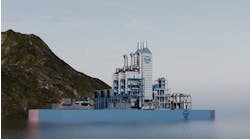Offshore oil & gas industry spend forecast to surge to $247 billion by 2010
Offshore staff
(UK) - Daily offshore oil & gas production, currently standing at around 43 MMboe, is forecast to grow to 53 MMboe in 2010 and drive industry annual expenditure from $193 billion in 2006 to $248 billion by 2010.
The World Offshore Oil and Gas Production & Spend Forecast, a study on the prospects for the offshore oil & gas industry, is published by Douglas-Westwood and based on information in the Energyfiles database.
Speaking at the Offshore Technology Conference in Houston on Monday, Douglas-Westwood's Managing Director John Westwood said, "High oil & gas prices over the period to 2010 will result in continued strong growth in the offshore oil & gas sector.
"Over the next five years we expect annual capital expenditure to increase by 10% from just under $110 billion in 2006 to $120 billion in 2010, but the real star of the show will be the less glamorous operational sector with a forecast growth of 53%, from $83 billion to $127 billion."
Report lead author Dr. Michael R. Smith said, "offshore spends are increasing rapidly but there are considerable differences across the regions.
"The main causes for the disparities are an increasing shortage of lower-cost prospects in all but the Persian Gulf and the limited availability of deepwater sedimentary areas with potential for oil and gas reserves outside those already identified in Brazil, the Gulf of Mexico, West Africa, and some other less prominent regions.
"Nevertheless all markets will retain ever-higher levels of operating expenditure. Overall, we expect West Africa to show the greatest growth at nearly $13 billion."
The report stresses that new activity in the mature offshore regions will increasingly become dominated by existing and new start-up small oil companies (along with the relevant national oil companies) as producing and exploration assets are acquired by smaller companies that specialize in marginal field developments and in scavenging for tail-end production.
However, a particular concern is that over the next three years most sectors of the offshore industry will be equipment- and people resource-constrained.
Day rates will remain high, especially for capital assets such as high specification drilling rigs and other vessels.
The experienced personnel needed to design, build, and operate drilling and production equipment will also command a growing premium.
However, it is noted that new rigs have already begun to enter the market and are now serving to moderate day rate growth. These restraints are reinforced by limits on opportunities in offshore regions available to private oil & gas companies.
The offshore market forces directing the industry toward new cost-cutting technology and other commercial innovations are strengthening.
In this sphere the greatest challenges faced by technology developers remain problems related to the conversion of new products into proven hardware, in particular the reticence by oil companies to introducing unproven equipment into a high technology project.
New low-risk ways of product introduction are needed for both technology developers and oil companies to field-prove new technology.
In the light of growing offshore expenditure, another challenge that both the oil companies and their contractors face is that of accessing human resources.
"The 'skills shortage' may in time be addressed as new people enter the industry attracted by higher salaries. But the 'experience shortage' is far more challenging, and there exists a growing potential for both technical and strategic mistakes to be made by inexperienced personnel acting in an environment of rapid technology advances," said Westwood.
Resource-limited growth is also of increasing concern, said Dr. Smith. "Besides the portfolios of a few NOCs operating in the Persian Gulf, the low marginal cost oil plays have virtually disappeared.
"Opportunities for finding and developing large offshore oil fields with relatively benign subsurface and reservoir conditions are now rare. Only the most demanding environments in ultra-deep waters and Arctic regions are expected to offer new large scale opportunities by the end of the period."
"Conversely, offshore gas still has opportunities related to the advent of new gas production and conversion technologies, the growth of gas markets in the developing world, and pressures by all governments to eradicate gas flaring.
"LNG projects and the beginnings of a GTL industry are kickstarting the development of stranded gas fields that have been lying fallow for many years and are also encouraging new exploration drilling in gas-prone areas.
"Considerable growth is forecast for all forms of deepwater production facilities, but especially floating production systems and subsea production and processing hardware.
"Subsea systems are also expected to attract an increasingly larger part of the shallow water offshore spend as marginal development programs escalate."
The report concludes that "offshore production forecasts show that the lengthy era of relatively low-cost oil and gas sources has ended. Higher oil and gas prices are here to stay - an oil price collapse could only be driven by a world-scale economic and/or political crisis that interrupts demand growth."
As we move beyond 2010, the future of companies operating in the offshore E&P industry will become increasingly vulnerable to outside economic and political circumstances.
The period from 2010 to 2015 is still expected to be "the time period when global oil production from all offshore and onshore sources, including unconventional sources, will become seriously resource-limited and year-on-year declines in global oil output will begin.
"During the transition period, while new transport fuels will have to be developed, the world will need all the offshore oil it can get."
05/01/06


